-
Paper Information
- Previous Paper
- Paper Submission
-
Journal Information
- About This Journal
- Editorial Board
- Current Issue
- Archive
- Author Guidelines
- Contact Us
International Journal of Optics and Applications
2012; 2(4): 48-55
doi: 10.5923/j.optics.20120204.04
Optical Remote Sensing of Pristine and Coastal Aerosol Features over the Arabian Sea
P. C. S. Devara 1, C. P. Simha 1, S. K. Saha 1, K. N. Babu 2, A. K. Shukla 2
1Indian Institute of Tropical Meteorology, Dr. Homi Bhabha Road, Pashan, Pune 411008, India
2Space Applications Centre, ISRO, Ahmedabad 380015, India
Correspondence to: P. C. S. Devara , Indian Institute of Tropical Meteorology, Dr. Homi Bhabha Road, Pashan, Pune 411008, India.
| Email: |  |
Copyright © 2012 Scientific & Academic Publishing. All Rights Reserved.
This paper purports the results of a comparative study conducted to investigate aerosol optical, microphysical and radiative characteristics over an Exclusive Economic Zone (EEZ) associated with pristine environment, and coastal regions influenced by human activities, during 2009-2011. The measurements over the EEZ of the Arabian Sea (AS) were carried out from Sagar Kanya (SK-226) ship while over the coastal locations (Mumbai and Goa); employing Sun-photometers. The aerosol optical thickness (AOT) at 500 nm was found to be in the range of 0.3-0.45 in the EEZ while it was 0.45-0.75 in the coastal regions. The AOTs at all the three sites showed a good association with concurrent meteorological parameters. Angstrom parameters (alpha and beta, representative of aerosol size distribution and loading, respectively) indicated opposite behavior in the pristine (EEZ) but similar trend in the polluted coastal regions. This feature reveals that the aerosol loading over the EEZ is contributed by coarse-mode particles while the fine-mode particles contribute to the loading over coastal regions. Abundance of fine-mode particles over the coastal regions is also evidenced from the second order polynomial fit coefficients (a1 and a2) of alpha. This aspect corroborates the long-range transport of air-mass over the experimental sites from the western coast India.
Keywords: Aerosols, Extinction, Exclusive Economic Zone (EEZ), Western Coast, Arabian Sea, Aerosol Radiative Forcing, Ocean Color Monitor
Article Outline
1. Introduction
- Aerosols are an integral part of the atmosphere and oceans. Along with greenhouse gases, they can affect climate in several ways. Aerosols can directly or indirectly influence the radiation budget and affect dynamics[1-2]. The direct radiative effect is due to scattering, absorption and emission properties of the aerosol particles. Aerosols are an enigmatic yet indispensable component in global climatic studies and modelling[3]. The physicalcharacteristics, composition, abundance, and spatial distribution and dynamics of aerosols are still very poorly known[4]. The spectral Aerosol Optical Thickness (AOT) or Depth (AOT) is an important physical parameter for characterizing aerosols. Routine observation of total atmospheric column AOT globally is a fundamental way of determining aerosol optical characteristics and their influence on global radiation budget and thereby climate change. The most practical means of making these observations is by remote sensing, which can be either from the ground (looking in the skyward direction with Sun-photometers) or from space (looking towards the ground through the atmosphere with image radiometers onboard satellites or high-altitude aircraft).Ground-based and satellite remote sensing of AOT are complementary to each other. Ground-based observations enable the acquisition of data as many times as possible in one day, but only for individually discrete locations[5]. On the other hand, satellite observations can cover more extensive areas of the earth (even the whole earth) in one day, though only one or two observations can be made on a given position each day. Ground and satellite observations are vital for different situations as well as for cross-validating each other[6-7]. A Number of currently available satellite sensors (for example, MODIS, MTP, TOMS, OCM-II in Ocean Sat-II) provide data for retrieving aerosol optical properties. On the other hand, there are a number of networks of ground-based Sun-photometers measuring AOT at different locations around the world. One such prominent network is the Aerosol Robotic Network (AERONET) comprising a series of automatic tracking sun-photometers currently occupying more than 350 locations in different parts of the world[8]. However, AERONET Sun-photometers cannot be located everywhere, and every time AOT data are needed, such as during some field campaigns and other special events, as well as routine measurements applied to certain specific studies. Therefore, there is a great need for alternative (especially portable and low-cost) Sun-photometer for such purposes.Marine aerosols are mainly sea-salt particles originated from wave-breaking and sulfate particles produced by the oxidation of Di-Methyl Sulfide (DMS), released by the phytoplankton[9]. Being hygroscopic, marine aerosols are crucial in cloud formation in the marine boundary layer and are also important in the radiative coupling between the ocean and atmosphere. While continental aerosols can be both scattering and absorbing, marine aerosols are mostly of scattering type[10]; thus becoming a decisive factor in the Albedo of the earth. In spite of the ever-widening recognition of the direct and the indirect radiative effects of aerosols, they are still poorly characterized in climate models[11].During the months of December–February, north-easterly wind over the Indian subcontinent carries aerosols from the land towards the oceanic atmosphere, affecting also the coastal regions. These months, therefore, become most ideal period to study the effect of continental aerosols and their dispersal in the oceanic atmosphere. Most of the in-situ data campaigns for aerosol characterization have provided significant information on spectral variability, aerosol type, particle size etc; however, in-situ data could not provide information on the spatial distribution and transport process. Routine monitoring of aerosol events and their subsequent dispersal pattern are important in order to understand their role in the climatic processes. The present paper focuses on the temporal, spatial and spectral variations of AOT over the EEZ (Arabian Sea) and coastal locations[Mumbai (formerly known as Bombay) and Goa], based on Sun-photometric measurements made on-board research vessel, Sagar Kanya; and near the coast over land and sea regions.
2. Study Area and Data
2.1. Arabian Sea
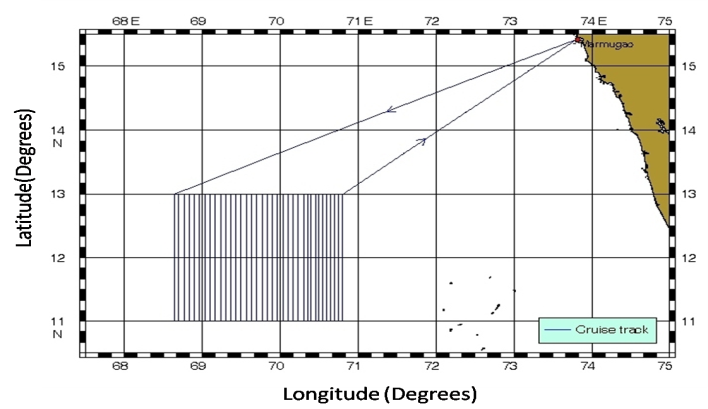 | Figure 1. Cruise track of SK-266 |
2.2. Coastal Station
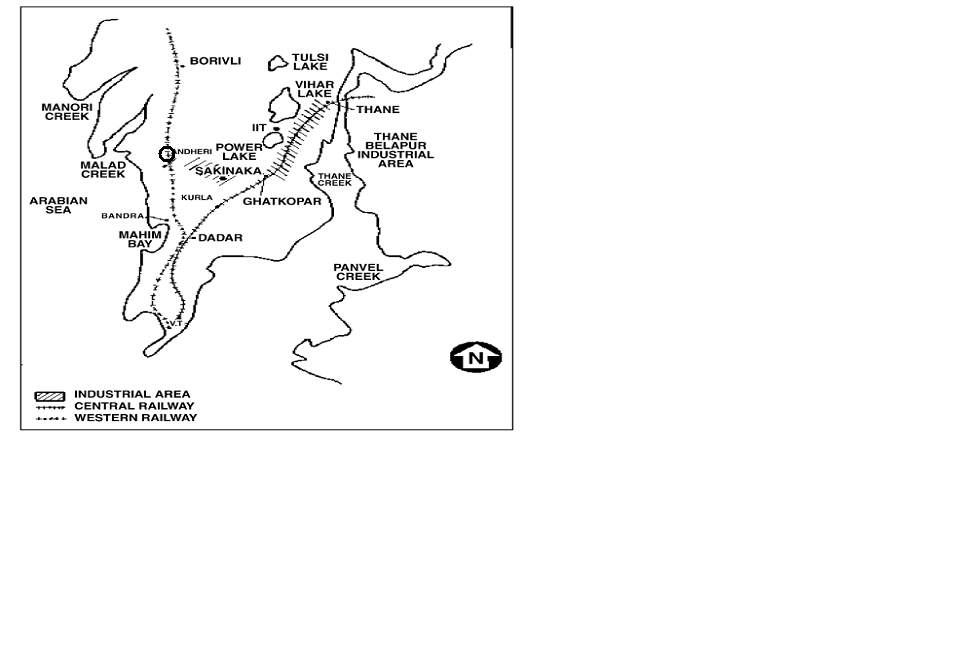 | Figure 2. Layout of the coastal site (Mumbai) |
3. Material and Methods
- The AOT measurements were made using a multi-spectral MICROTOPS-II Sun-photometers (M/s Solar Light Co., USA). They measure AOT at six wavelengths centred at 380, 440, 500, 675, 870, 1020 nm, from the instantaneous solar flux measurements using its internal calibration. These instruments work on the principle of measuring the solar radiation intensity at each wavelength and convert to AOT by knowing the corresponding intensity at the top-of-the-atmosphere (TOA). The TOA irradiance at each wavelength was calculated via the well known Langley method. For this, the expression given by Kasten and Young[22] for the air mass computation was used. The absolute irradiance in Wm–2 is obtained by multiplying the irradiance signals at different wavelengths in mV with the calibration factor (Wm–2mV-1). The accuracy of the sun-targeting angle is better than 0.1o. In order to avoid errors in sun-targeting angle, the photometer was mounted on a tripod stand through-out the experimental period. Moreover, before their deployment for cruise observations, the Sun-photometers were factory calibrated at Mouna Loa, Hawai, a unique high-altitude location allowing access to a pure and stable atmosphere. Thus the on-board measurements were carried out following the standard AOT measurement protocol for ship-borne surveys. During the cruise, the photometers were operated from 08:00 hrs to 16:00 hrs, with 5-min interval during sun-rise and sun-set periods; and 10-min interval during rest of the day. These measurements were made from the ship-deck when the sky was cloud-free or when clouds were far away from the solar disk. Simultaneous surface-level meteorologicalobservations like wind speed, relative humidity etc. was recorded by an automatic weather station (AWS) and the atmospheric pressure was measured with an on-board aneroid barometer.
4. Results and Discussion
4.1. Spectral and Lat/Long variations of AOT over the Arabian Sea
- The spectral dependency of AOT is studied during the morning, afternoon and evening periods over the EEZ and coastal site (Goa) of the Arabian Sea in Fig. 3. The morning
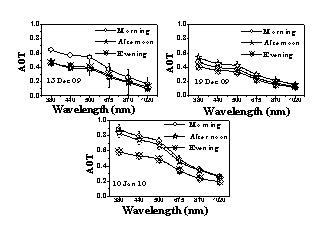 | Figure 3. AOT variations during morning, afternoon and evening hours in different environment zones |
 | Figure 4. Variation of meteorological parameters over different environments |
4.2. Winter Versus Pre-monsoon Variation of AOT and Meteorological Parameters Over Coastal Station
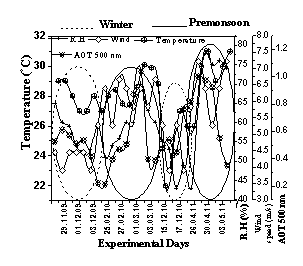 | Figure 6. Co-variations between AOT at 500nm and meteorological parameters |
4.3. Angstrom Coefficients and Air Back Trajectories Over the Arabian Sea
- According to Angstrom[26-27], spectral variation of AOT can be expressed as
 | (1) |
 | Figure 7. Alpha-Beta variations in different environmental zones (on different locations of the ship) |
 | (2) |
 | Figure 8. Second order Polynomial coefficients a2 and a1 with AOT 500nm |
4.4. Intra-seasonal Variation in Angstrom Exponent Over the Coastal Site
- The relationship between α and β variations and their covariance with that of AOT[26, 33] during winter and pre-monsoon seasons over the coastal site (Mumbai) is examined in Fig. 9. The alpha values range from 0.2 to 0.7 in winter while they vary between 0.3 and 1.2 in pre-monsoon season. It is clear from this figure that alpha follows similar trend as that of AOT throughout the study period except in the winter season of 2010 due to lack of particle growth. The accumulation-mode aerosol is smaller during winter 2009 and higher during winter 2010. Generation of coarse-mode particles is observed to be predominant during pre-monsoon and winter seasons of 2009 and 2011. This may be due to the lower turbidity coefficient (beta) and associated meteorological parameters, leading to agglomeration of aerosols during those seasons over coastal station.
 | Figure 9. Angstrom exponent variations over coastal site (Mumbai) during the campaign period. Pre-monsoon variations are enclosed by solid circles and winter variations by dashed circles |
 | Figure 10. Air mass back trajectories from NOAA Hysplit model during the campaign period at different altitudes (500 m, 1500 m, 2000 m) |
4.5. Diurnal Variation of SW Radiation over the EEZ And Coastal Sites
- The data over the Mumbai coast were acquired by fixing the Pyranometer on the roof of a five-stored building to avoid topographic obstructions while these measurements were made by mounting the pyranometer to specially-built gimbals fixed to the ship deck. Details of this instrument can be found in Devara et al.[35]; Kalapureddy et al.[29]; Kalapureddy and Devara[30]. The down-welling radiation flux variations recorded on two typical experimental days, one in winter 2009 over EEZ and the other in pre-monsoon 2010 over Mumbai coast, are shown plotted in Fig. 11. It can be noted that sky was relatively clean during the period of observations over the EEZ as compared to the coastal location, where the sky was covered by cloud patches (indicated by reduction in the flux as evidenced by inverted spikes). The surface radiative forcing due to aerosols is computed by coupling these observations (during clear sky conditions) with the concurrent Sun-photometer AOT measurements, and the details are presented and discussed in the sub-section to follow.
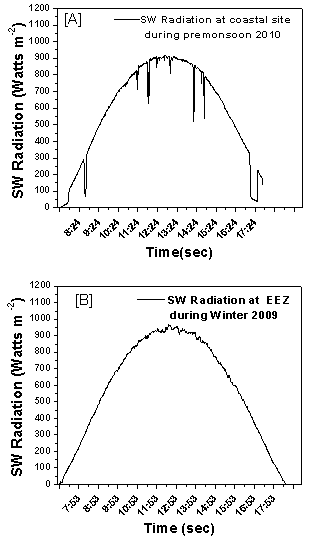 | Figure 11. Seasonal variation of SW radiation over the coastal site[A] and EEZ[B] of the Arabian Sea. Contamination by clouds can be seen over the coastal site |
4.6. Surface Radiative Forcing
- The pyranometer-measured global SW flux values in the wavelength region from 0.3 to 3.0 μm are correlated with instantaneous AOT at 500 nm values (corrected for the air mass factor, 1/μ) in order to compute the radiative forcing[25]. Normalization of AOT with μ (= cos θ) is necessary as the slant air column length increases with increasing solar zenith angle θ. The data for solar zenith angle greater than 60o are excluded (to avoid Earth's curvature effect) and the AOT/μ values are restricted to within 0.85. Figure 12 shows scatter plots of the measured normalized SW flux with AOT for the EEZ and coastal region. A straight line could be fitted with a negative slope of about 20.08 and 31.02 Wm−2 per unit optical thickness for the EEZ and coastal region. This implies that for 0.1 increase in the prescribed columnar AOT, the sea-surface solar flux decreases by about 20.08 and 31.02 Wm−2 for EEZ and coastal regions. This is consistent with the surface solar flux values reported by earlier researchers (for example, Kalapureddy and Devara[24]; Jayaraman et al.[25]; Moorthy et al.[36]).
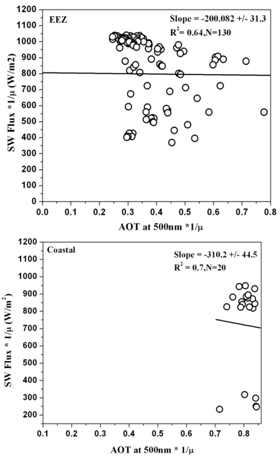 | Figure 12. Association between the short wave solar flux and columnar AOT at 500nm normalized with the air mass (1/µ) over coastal Arabian Sea and EEZ |
5. Conclusions
- As part of the Calibration-Validation (Cal-Val) campaign of OCEANSAT-II OCM (Ocean Color Monitor), aerosol characterization experiments have been conducted over the coastal and pristine environments of the Arabian Sea. The salient results obtained are summarized below. • Relatively higher values of Angstrom exponent, 1.2 near the coast, and 0.2-0.8 in the EEZ were observed during the cruise period. These values indicate the presence of smaller particles near the coast due to anthropogenic activities, and relatively larger particles in the EEZ due to advection from Indian subcontinent. This feature was clearly seen supported by long-range transport of air mass to the experimental site. • Combined information of Angstrom exponent (α) and its second order derivative have been found to be useful indicators to delineate aerosol type and loading.• Surface radiative cooling due to aerosols is found to be larger over the coastal Arabian Sea than that over the EEZ. • In the EEZ, the AOT was found to vary around 0.2 (representing pristine oceanic condition), whereas near the coastal region, AOT was more than 0.5 indicating significant anthropogenic activity. Both the hygroscopic growth of particles and generation of organic aerosols have been noticed during the cruise.• Combined a1 and a2 values showed fine-mode dominance over the coastal locations and coarse-mode abundance over the EEZ, which is considered to be due to anthropogenic activities and long-range transport of air mass from the Indian continent.• The aerosol forcing (cooling) exerted by the sea surface solar flux (ΔF) over the coastal (-20 Wm-2) is found to be less as compared to that over the EEZ (-31 Wm-2) in the Arabian Sea during the SK-266 campaign.• Intra-seasonal variation of AOT over the coastal station (Mumbai) is found to be in the range of 0.4-0.6, 0.4-1.1 during winter and pre-monsoon seasons, respectively. A significant influence of long-range transport of aerosol pollutants and local meteorological parameters on AOT is noticed during winter and pre-monsoon seasons.
ACKNOWLEDGEMENTS
- The authors are grateful to the anonymous Reviewers for their insightful comments on the original manuscript. This work was carried out under the ISRO-SAC, OCEANSAT-II project. The authors are thankful to the Crew Members and Scientific Team of the ORV-Sagar Kanya (SK-266). One of the authors (CPS) is very thankful to SAC, ISRO for financial support. Authors are thankful to the Director, IITM for all the support for the study. Thanks are also due to Latha Shenoy of the Central Institute for Fisheries and Education (CIFE), west Andheri, and DRDO, Mumbai, for providing infrastructure support for coastal observations. The authors gratefully acknowledge the NOAA Air Resources Laboratory (ARL) for providing the HYSPLIT transport and dispersion model and/or READY website (http://www.arl.noaa.gov/ready.html). We are thankful to the web-based interface for the visualization and analysis of the MODIS data (http://g0dup05u.ecs.nasa.gov/Giovanni/).
 Abstract
Abstract Reference
Reference Full-Text PDF
Full-Text PDF Full-Text HTML
Full-Text HTML